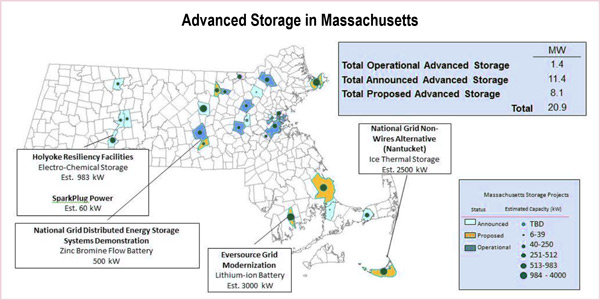By Michael Kuser
Massachusetts officials said Friday the state’s electric distribution utilities must procure a combined 200 MWh of energy storage by Jan. 1, 2020 — an unambitious goal to some observers.
Although the Department of Energy Resources’ (DOER) announcement called the 200 MWh “an aspirational” target, some industry stakeholders expected more from Gov. Charlie Baker’s Energy Storage Initiative. The department’s State of Charge report, released in September, presented recommendations for generating 600 MW of advanced energy storage by 2025, saying it would capture $800 million in system benefits. (See Mass. Considering Storage Mandate.)

| DOE Global Energy Storage database and Massachusetts Department of Energy Resources
“Based on lessons learned from this initial target, DOER may determine whether to set additional procurement targets beyond Jan. 1, 2020,” DOER Commissioner Judith Judson said in announcing the target. The state also agreed to spend $10 million on energy storage demonstration projects in addition to the $10 million that accompanied the ESI announcement in May 2015.
Judson said the state also had begun implementing other recommendations from the State of Charge report, allowing storage to be paired with the state’s plans to procure 9.45 million MWh of clean energy and 1,600 MW of offshore wind.
She also said the state was “incentivizing” storage through the Solar Massachusetts Renewable Target (SMART) program and that storage would be funded by alternative compliance payments under the ACES Grant Program, the Peak Demand Reduction Grant Program and the Community Clean Energy Resiliency Initiative, and that storage would be eligible for future Green Communities grants.

| Massachusetts Department of Energy Resources, Massachusetts Clean Energy Center
It also is considering allowing utilities to use energy-efficiency funds for storage that provides sustainable peak load reductions and expanding energy storage in the Alternative Energy Portfolio Standard.
“It’s less of an aspirational target, something the state’s going to strive for, and more a description of what the state is already doing,” said Ted Ko, director of policy at Stem, a provider of commercial-scale energy storage. “It’s entirely possible they would have met [the target] anyway. For example, Eversource [Energy] has already proposed over 180 MWh of storage projects in a recent rate case.”
Ko said the SMART program, whose regulations were released last month, “by itself conceivably could come up with 100 MWh.”
“Essentially, by setting a low, voluntary target number, you’re not inspiring any new programs or new initiatives as outlined in the State of the Charge report,” he added.
The announcement drew similar, if more temperate, comments from others, including Chris Rauscher, director of public policy at residential solar company Sunrun.
“The decision by DOER to set a soft energy storage target of 200 MWh is a moderate first step in providing long-term market surety,” Rauscher said. “Growing the storage market in Massachusetts has the potential to support local job creation and lower costs for Massachusetts ratepayers, all while providing critical resiliency through backup power.”
Rauscher said the company would work with legislators to expand storage’s potential “by encouraging private investment in Massachusetts through programs like the Alternative Energy Portfolio Standard.”
The Energy Storage Association noted that Massachusetts utilities previously proposed “specific, albeit voluntary, procurement targets of a combination of up to 200 MW/500 MWh of energy storage. Today’s announcement is a more conservative step in that direction.
“Massachusetts is also competing for industry jobs with California, Oregon, New York and other states moving forward on their own storage procurement targets,” ESA added.
Massachusetts becomes the second state in the U.S. to mandate storage. The California Public Utilities Commission in 2013 ordered the state’s three large investor-owned utilities to add 1.3 GW of energy storage by 2020.
New York lawmakers last month passed a measure requiring the state’s Public Service Commission to set targets to increase the adoption of energy storage in the state through 2030. If signed by Gov. Andrew Cuomo, the new law would require the commission to work with the New York State Energy and Research Development Agency and the Long Island Power Authority to set up a storage deployment program. (See NY Bill Sets Stage for Storage Targets.)


